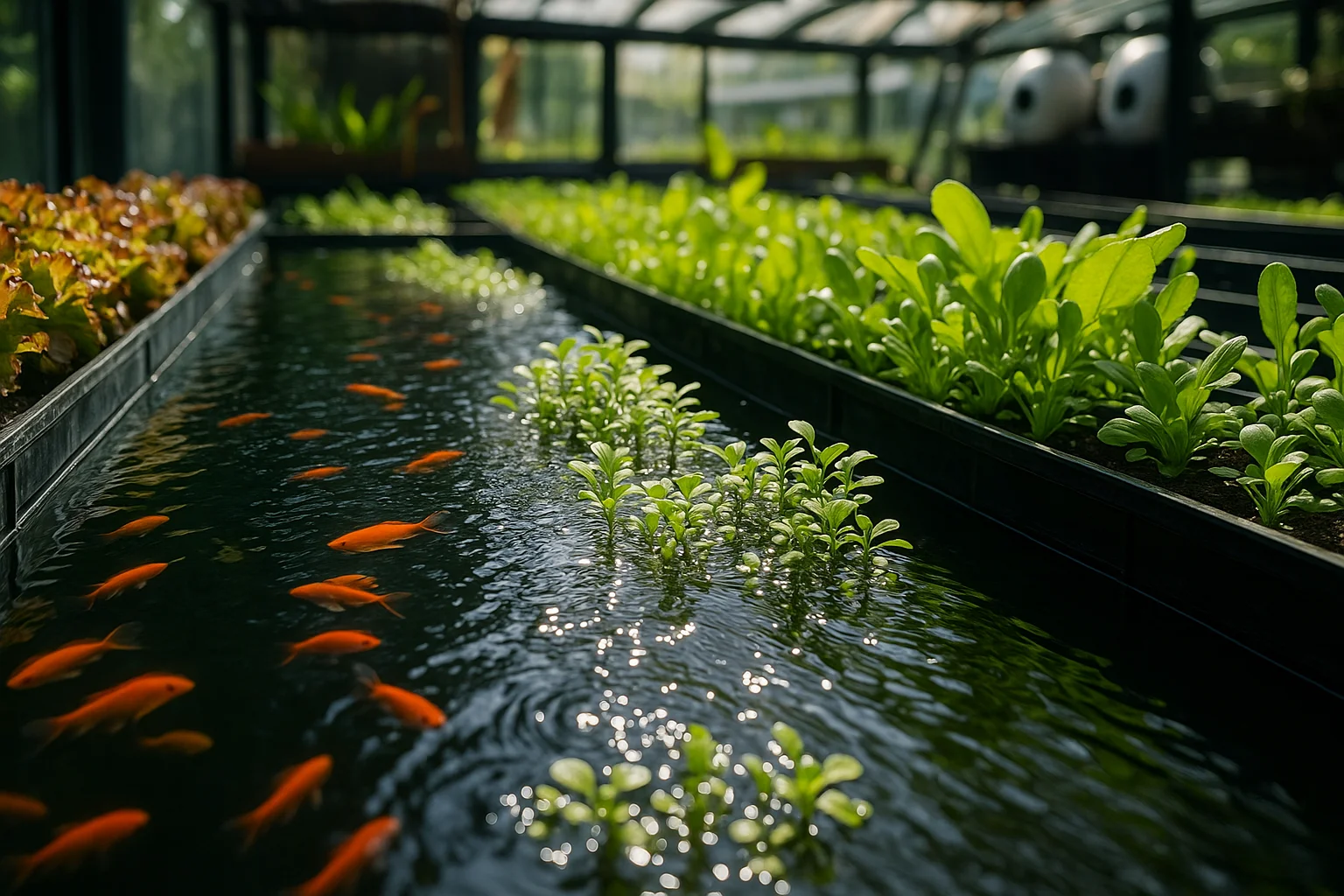1. Introduction to Aquaponics and Hydroponics
Aquaponics and hydroponics are two innovative soilless farming methods that maximize resource efficiency. While both systems grow plants without soil, they differ in nutrient sources, complexity, and sustainability.
- Aquaponics combines aquaculture (fish farming) with hydroponics, using fish waste as a natural fertilizer.
- Hydroponics grows plants in nutrient-rich water without fish, relying on synthetic fertilizers.
2. How Aquaponics Works
Aquaponics is a closed-loop system where:
- Fish produce waste (ammonia).
- Beneficial bacteria convert ammonia into nitrates.
- Plants absorb nitrates, filtering the water.
- Clean water returns to the fish tank.
Example: A small-scale aquaponics system can produce 50–100 lbs of fish and 200–300 lbs of vegetables annually (Source: USDA).
3. How Hydroponics Works
Hydroponics involves growing plants in water with added nutrients. Common systems include:
- Deep Water Culture (DWC): Roots submerged in nutrient solution.
- Nutrient Film Technique (NFT): Thin film of water flows over roots.
- Ebb and Flow: Periodic flooding and draining.
Example: Hydroponic lettuce grows 30–50% faster than soil-grown lettuce (Source: University of Minnesota Extension).
4. Key Differences Between Aquaponics and Hydroponics
| Factor | Aquaponics | Hydroponics |
|---|---|---|
| Nutrient Source | Fish waste (natural) | Synthetic fertilizers |
| System Complexity | Higher (manages fish + plants) | Lower (only plants) |
| Startup Cost | $500–$2,000 (small system) | $300–$1,500 (small system) |
| Maintenance | Moderate (fish health monitoring) | Low (nutrient balancing) |
| Water Usage | 90% less than soil farming | 70–90% less than soil farming |
5. Pros and Cons of Aquaponics
Pros:
- Organic, chemical-free produce.
- Dual harvest (fish + plants).
- Highly sustainable (closed-loop).
Cons:
- Higher initial cost.
- Requires fish care knowledge.
- Slower plant growth than hydroponics.
6. Pros and Cons of Hydroponics
Pros:
- Faster plant growth.
- Lower startup cost.
- Easier to scale commercially.
Cons:
- Relies on synthetic nutrients.
- Higher risk of system failure (e.g., pump issues).
- Less sustainable than aquaponics.
7. Cost Comparison: Aquaponics vs Hydroponics
Initial and operational costs vary significantly. Here’s a breakdown for a small-scale system (100 sq ft):
| Cost Factor | Aquaponics | Hydroponics |
|---|---|---|
| Setup Cost | $1,000–$3,000 | $500–$1,500 |
| Fish Stocking | $50–$200 (e.g., tilapia) | N/A |
| Nutrients/Fertilizers | $0 (fish waste) | $20–$50/month |
| Electricity | $15–$30/month | $10–$25/month |
| Maintenance | $50/month (fish feed, pH tests) | $30/month (nutrient solutions) |
Source: University of Arizona Controlled Environment Agriculture Center (2023).
8. Yield Comparison: Which System Produces More?
Hydroponics generally offers higher plant yields, but aquaponics provides dual output (fish + plants).
| Crop | Aquaponics Yield (per sq ft/year) | Hydroponics Yield (per sq ft/year) |
|---|---|---|
| Lettuce | 10–15 lbs | 15–20 lbs |
| Tomatoes | 8–12 lbs | 12–18 lbs |
| Basil | 5–8 lbs | 8–12 lbs |
| Fish (Tilapia) | 20–30 lbs | N/A |
Note: Hydroponics yields 20–30% more plants, but aquaponics adds protein from fish (ResearchGate Study, 2022).
9. Maintenance and Labor Requirements
- Aquaponics:
- Daily: Feed fish, check water pH (6.8–7.2), ammonia (<0.5 ppm).
- Weekly: Clean filters, prune plants.
- Monthly: Harvest fish, replenish water.
- Hydroponics:
- Daily: Monitor pH (5.5–6.5) and nutrient levels (EC 1.2–2.5).
- Weekly: Refill nutrient reservoir, inspect roots for rot.
- Monthly: Flush and sterilize the system.
Labor Time: Aquaponics requires ~10 hrs/week vs hydroponics’ 5–7 hrs/week.
10. Environmental Impact and Sustainability
Aquaponics Wins:
- Water Use: Recirculates 90% of water (vs hydroponics’ 70%).
- Chemical-Free: No synthetic fertilizers (reduces runoff pollution).
- Carbon Footprint: 50% lower than hydroponics (fish replace fossil-fuel-based nutrients).
Hydroponics Drawbacks:
- Synthetic nutrients can leach into groundwater.
- Higher energy use for precise climate control.
Source: EPA Sustainable Agriculture Report (2021).
11. Best Plants for Aquaponics and Hydroponics
| System | Best Plants | Poor Choices |
|---|---|---|
| Aquaponics | Lettuce, kale, herbs (basil, mint), tomatoes, cucumbers | Root veggies (carrots, potatoes), blueberries (acidic) |
| Hydroponics | Strawberries, peppers, spinach, bok choy, orchids | Large plants (corn, wheat), heavy-feeders (pumpkins) |
12. Common Challenges in Both Systems
- Aquaponics:
- Fish mortality due to pH swings or disease.
- Slower plant growth during system cycling (4–6 weeks).
- Hydroponics:
- Algae growth in nutrient tanks.
- Power outages can kill plants in hours.
Pro Tip: Use backup battery systems for hydroponics and quarantine new fish in aquaponics.
13. Which is Better for Beginners?
Hydroponics is easier for starters:
- No live animals to manage.
- Faster results (harvest in weeks).
- Lower upfront investment.
Aquaponics suits those who:
- Want a hands-off nutrient system (fish do the work).
- Prioritize sustainability over speed.
Beginner Recommendation: Start with a $200 hydroponic Kratky system (no pumps) to learn basics.
14. Real-World Examples and Case Studies
Aquaponics Success:
- Sweet Water Organics (Wisconsin): Produces 10,000 lbs of fish + 50,000 lbs of greens/year on 1 acre (Source).
Hydroponics Dominance:
- AeroFarms (New Jersey): Grows 2M lbs of leafy greens/year in a 70,000 sq ft warehouse using vertical hydroponics (Source).
15. Future of Aquaponics and Hydroponics
- Aquaponics: Rising in urban farms due to organic demand. AI fish feeders are reducing labor.
- Hydroponics: Dominating commercial vertical farms (projected $16B market by 2027, per Grand View Research).
Innovation: Solar-powered aquaponics and IoT-based hydroponic sensors are cutting energy costs.
16. Final Verdict: Aquaponics or Hydroponics?
Choose Aquaponics if: You want organic produce + fish, prioritize sustainability, and don’t mind higher complexity.
Choose Hydroponics if: You want faster plant growth, lower costs, and simpler maintenance.
17. FAQs
Which is cheaper, aquaponics or hydroponics?
Hydroponics is generally cheaper to start ($300–$1,500) vs aquaponics ($500–$2,000).
Can you grow the same plants in both systems?
Yes, but hydroponics supports a wider variety (e.g., strawberries, tomatoes) due to precise nutrient control.
Is aquaponics more sustainable?
Yes, because it recycles water and eliminates synthetic fertilizers.


0 Comments